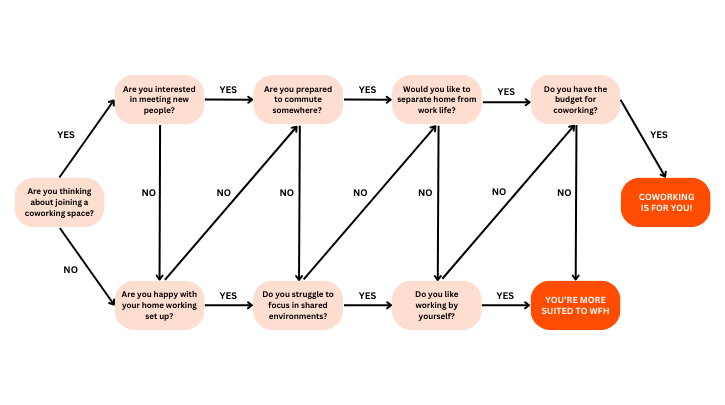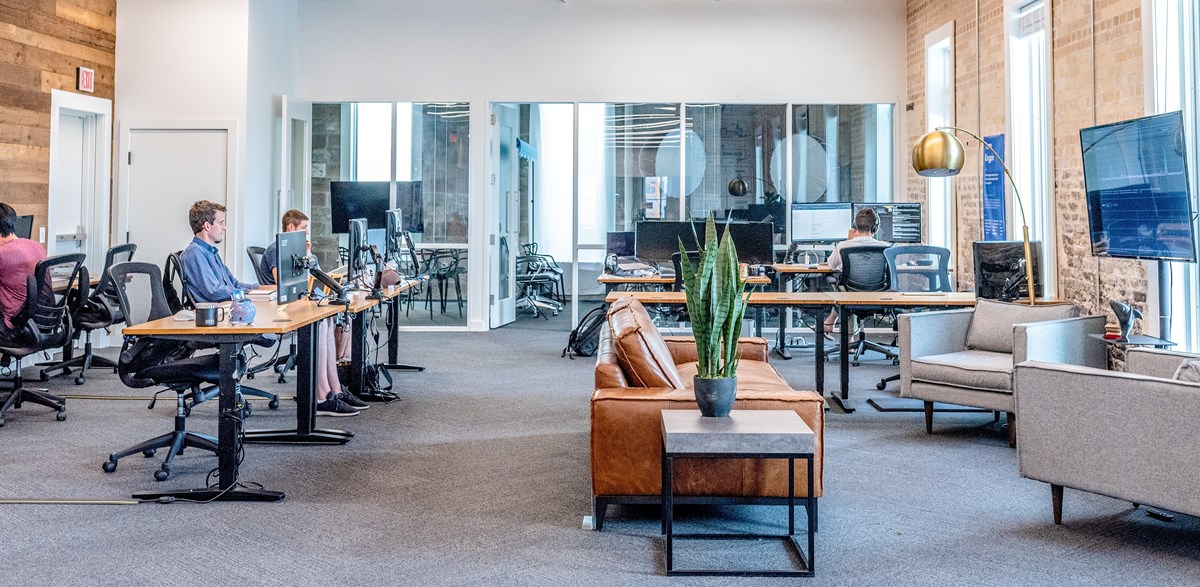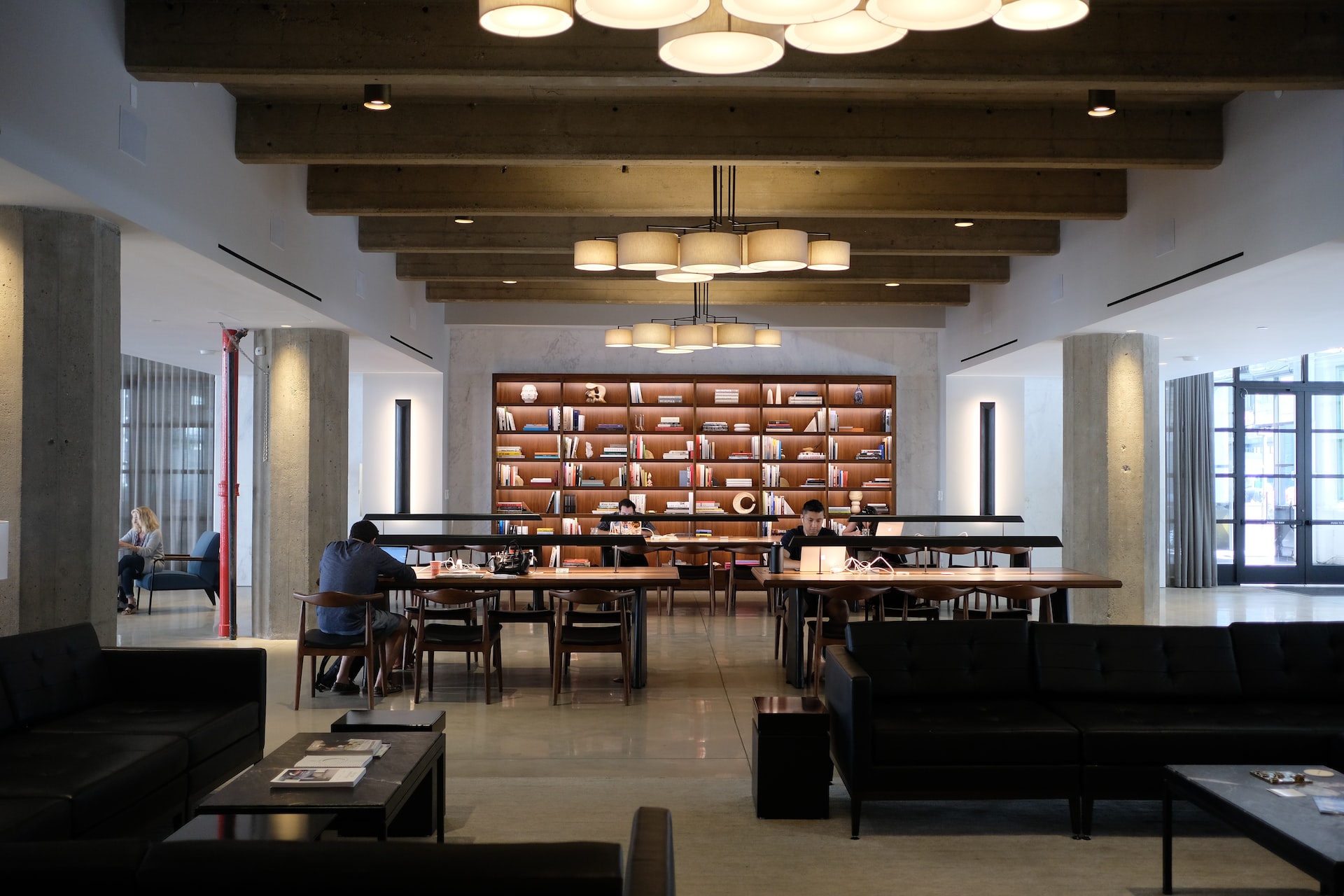- Coworking
Working From Home or Coworking. What’s Right for You?

Recently, I’ve found myself facing a workplace dilemma. For over two years, I belonged to a coworking space with a thriving community of like-minded freelancers. But I’m no longer part of that space, and somewhat reluctantly, my primary workspace has become my home. I’ve certainly felt the magic of coworking, and absolutely know that being part of a coworking space brings some incredible benefits. But for some reason, I just haven’t got around to joining another workspace. Not yet.
I’m not alone here. There are just over 2 million freelancers in the UK who, like me, choose where and how they work, and 165,000 Brits living globally as digital nomads. Meanwhile, 18% of the UK workforce works from home 100% of the time, including remote workers.
Remote work offers flexibility like we’ve never seen before, but it also brings an element of choice around where you work: do you stay productive at home, or do you seek structure and social interaction in a coworking space? The answer isn’t one-size-fits-all. So, if you’re on the fence about working from home vs coworking, let’s look at which one is the best workspace for remote work in 2025.

Flexibility and lifestyle fit
One of the biggest deciding factors around your workplace is how it fits into your lifestyle. This has always influenced my workplace decisions, with the first coworking space I joined located a 15-minute walk away from my home in Edinburgh. The morning commute was a glorious opportunity for some much-needed daily exercise and fresh air, and the coworking space was filled with people – a refreshing change following a year of lockdowns.
When I moved down to London the following year, I eventually found the perfect new coworking space, a 25-minute train ride away, which I commuted to around three days a week. A couple of years later, I moved and put more distance between me and my coworking workspace, which happened to shut down shortly after. By the time it had gone, I’d already left it, because the 50-minute commute was simply longer than I was willing to endure.
Today, I’m not sure I have the capacity to commute to a coworking space when my work takes me all over the city. Ultimately, how work fits around our lifestyles is one of the most important considerations, though it’s also deeply personal and varies from one person to the next.
Remote work is fundamentally about flexibility, and choosing between working from a shared office space vs a home office is personal. Working from home (WFH) offers comfort and convenience, especially in these winter months. But it might also be a necessity; parents have fragmented time, and a commute, even just a short one, might not be feasible alongside caregiving commitments. Equally, introverts may not feel comfortable working in a busy, shared environment, like a coworking space.
If you have fur babies, the good news is that many coworking spaces are dog-friendly. This is an attractive proposition for dog owners who may otherwise struggle with balancing social work settings with pet-sitting services. It also gives an extra advantage for all of us dog lovers to cowork, too!

Productivity and focus
If you work from home all the time, you might be questioning whether you need a coworking space at all. You might even imagine that coworking spaces are filled with remote workers spending their days chatting and making noise. That’s a big misconception around coworking.
While there are pros and cons of coworking. Workspace design, such as busy open-plan hot desk areas, can be distracting or even overwhelming for people, especially neurodivergents. But on the whole, coworking spaces are much more productive than you might think.
In fact, you’re just as likely to get distracted when you work from home. There’s always housework to do, deliveries turning up, and pets needing attention (or children). Remote work productivity requires achieving a state of flow. But every time we’re pulled out of a flow state, it takes about 10 minutes to settle back in. One of the blockers to achieving this? Distractions in our work environment. I know so many people who say they just can’t trust themselves to work productively, so they prefer working in an office (actually, working around others can spark productivity too).
In terms of productivity, choosing the best workspace for remote work really depends on knowing yourself best: how you focus and what types of environments help you thrive. Living in a noisy household full of distractions? Then a coworking space might suit you. Finding you can’t focus in a busy coworking space? Then home working could be for you (but I would challenge you here, as to whether you’ve found the right coworking space).
My preference has always been a mix of both. On days when I have less focused tasks, I might cowork and have more capacity to connect with others. When I’m writing, I need a quiet space, so WFH works best for me. Some days are a hybrid of the two. When it comes to choosing home working or coworking spaces, it’s a nuanced topic for many of us
Social interaction and isolation
Why do I enjoy coworking? The single, largest benefit to my life has been finding connection with others. When I was a member of the coworking space in London, I connected with a like-minded bunch of coworkers in the space, and we formed a really special community. This helped me achieve so many things, from business support, like airing problems and sharing ideas, to attending workshops and events that made all the difference.
On top of the professional benefits, being amongst others really was a lifeline. We’re social creatures after all, and being cooped up in isolation every day is unhealthy. That’s the biggest downside of home working. In fact, a 2021 survey conducted by Knight Frank found that working from home was negatively impacting 40% of workers and affecting their mental health. Loneliness can be dangerous, leading to heightened stress, anxiety, depression and a risk of diabetes.
The lack of separation between work and life while WFH can also lead many remote workers to burn out, as a result of working longer hours. Despite cutting out the commute, the danger is that you never stop working. You really need that rest time; sometimes, having a dedicated workspace away from home, like a coworking space, is absolutely necessary to achieve a healthier work-life balance.
On the topic of social interaction vs loneliness, the verdict is clear: coworking wins.
Costs and hidden expenses
But what about costs? While you might think WFH is the cheaper option, there are some hidden expenses to consider. For instance, home working increases electricity and heating usage. When you’re turning on the heating in the winter and air-conditioning or a fan in the summer, switching lights on, and using appliances like your kettle or coffee machine for making hot drinks, or the oven for making lunch, it all costs you.
In the winter of 2020, research found that WFH was increasing heating and electricity bills by £45 every month. Five years on, that figure is likely to have increased, given the rising cost of living.
Keeping overheads low at home is a real driving force for many coworkers. But what’s the true cost of coworking? It might look like the following.
Membership or day pass
The main cost of coworking is the cost of a membership or, if you’re looking for more hybrid options, a day pass. Earlier this year, the average cost of a hot desk in a UK coworking space was £156, with dedicated desks priced at £210. If you’re looking for more ad-hoc options, booking a day pass here and there, or looking at bundles on coworking passes can meet smaller budgets.
Commute
Now this all depends on where you’re planning to work. If you’re looking to get out of your house for work, your best bet for minimum costs involves joining a space that you can walk or cycle to. Active travel methods are best for your carbon footprint. Otherwise, you’ll end up paying for train or bus fares, petrol or parking. With commuting, often, the true cost is time – the average commute loses you an hour each way.
Food and drink costs
You may also need to consider additional costs to cover lunch and coffee. Some coworking spaces provide unlimited coffee as part of your membership, from their machines. But many don’t, so you may need to consider this when shopping around for workspaces. At most coworking spaces, you can bring your own lunch in, but it never hurts to support the local businesses in the area for food and drink!
Although joining a coworking space requires some investment, think of it as investing in yourself and your professional development. The benefits will far outstrip any negatives.

Amenities and infrastructure
The beauty of coworking is its flexibility and, in addition to being able to cowork ad-hoc at many spaces, you can also benefit from the amenities coworking provides on a flexible basis, too. For example, if you’re searching for a professional space to make an IRL meeting with a coworker or client, check out some of the meeting rooms available in your local coworking space, or a space in the desired neighbourhood you’d like to meet in.
If your home internet goes down, coworking has your back, too. Most coworking spaces have lightning-fast internet, making them a fantastic backup plan when you desperately need a connection. I found my workspace’s connectivity a lifesaver when I first moved to London, as my upload speed was too slow at home, relying on very outdated infrastructure in my building. It made certain projects impossibly slow (I’m talking hours instead of minutes), so it made more sense to pop into a coworking space to work on these tasks.
Printers are another great perk of coworking; many people don’t even own a printer at home, with extortionate running costs making printer ownership more a thing of the past. But there’s always the odd occasion you need to print something. Instead of panicking, just book a day pass at your local coworking space and ask the community manager to help you.
A huge benefit of joining a coworking space for freelancers is that a business address is often included in your membership. Freelancers, if you’d rather not disclose your home address to clients, this perk is for you. Today, the range of membership tiers in coworking businesses means you don’t even need to commit to a space. Often, virtual or lighter memberships include an office address.
Have I convinced you to try coworking yet
Which workspace is best for you?
If you’re still unsure whether home working or coworking is right for you, let this flowchart help you decide. Discover which workspace truly suits your working style:

Coworking is my middle ground
Before you commit to one workplace over the other, here’s something important to remember: it doesn’t have to be all-or-nothing. One of the biggest advantages of remote work today is that you can design a working rhythm that adapts to your schedule, your energy levels, and your week-to-week needs. That’s exactly where coworking shines, because it’s flexible.
You don’t need to join a space full-time to benefit from it. Many people, myself included, find that mixing home working with ad-hoc coworking days creates the perfect balance. Some weeks, I’m happiest at home when I need deep focus. Other days, I’ll head to the coworking café near my gym, tie a workout into my lunchtime routine, and enjoy being around others without committing to a full membership. Every so often, I’ll book a day pass at a coworking space to work alongside a friend.
This is where my head’s at right now: the flexibility of coworking means you don’t have to commit to one space. To be totally honest, I’m still not over the beautiful coworking community I belonged to for two years, although I know I will move on eventually.
Maybe you’re in a similar situation. The great thing is that coworking doesn’t have to be the same space every time. That’s part of the fun. Try out a few different environments, neighbourhood hubs, creative studios, urban centres, and coworking cafes, to help you discover what genuinely supports your productivity and wellbeing. You may find yourself feeling less lonely than when WFH. You might come across a community that you truly feel connected to; whatever the experience is for you, it’s personal.
So, which is the best for remote work? Working from home or coworking? The reality is, it depends entirely on you. Your lifestyle, your focus needs, your social needs, your budget, and your working rhythms all shape that answer. For some remote workers, WFH is an ideal sanctuary for deep focus and comfort. For others, coworking provides structure, community, and a healthier separation between work and life.
But for many of us, the sweet spot lies somewhere in the middle.
Want to know more about
how Nexudus could help your business?
We’re here to answer any questions you have.
Latest articles
-

- Coworking
- Coworking News
The 7 Best Female-Focused Coworking Spaces (And Why They Matter)
Kate Tattersfield on October 30, 2025 -

- Coworking
- Coworking Resources
What Are the Top Coworking Listing Sites to Promote Your Space?
Coworking listing sites are becoming increasingly popular. They’re free to use and save those looking for an...
Kate Tattersfield on October 1, 2025




